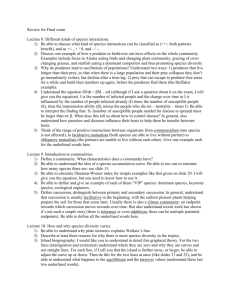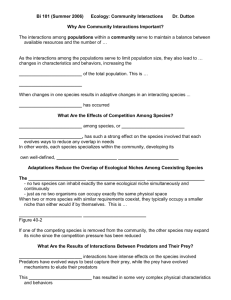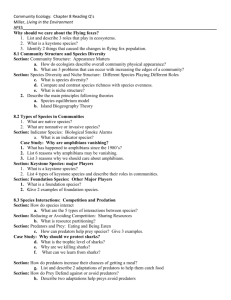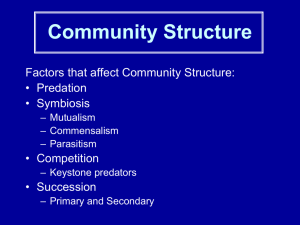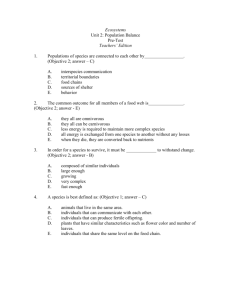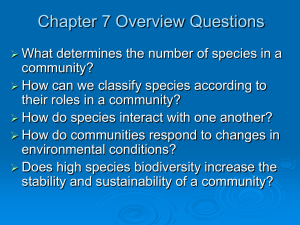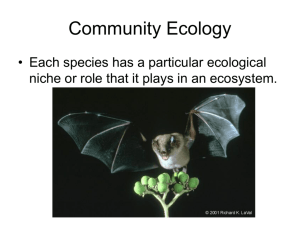Chapter 7 Community Ecology Core Case Study: American Alligator
advertisement
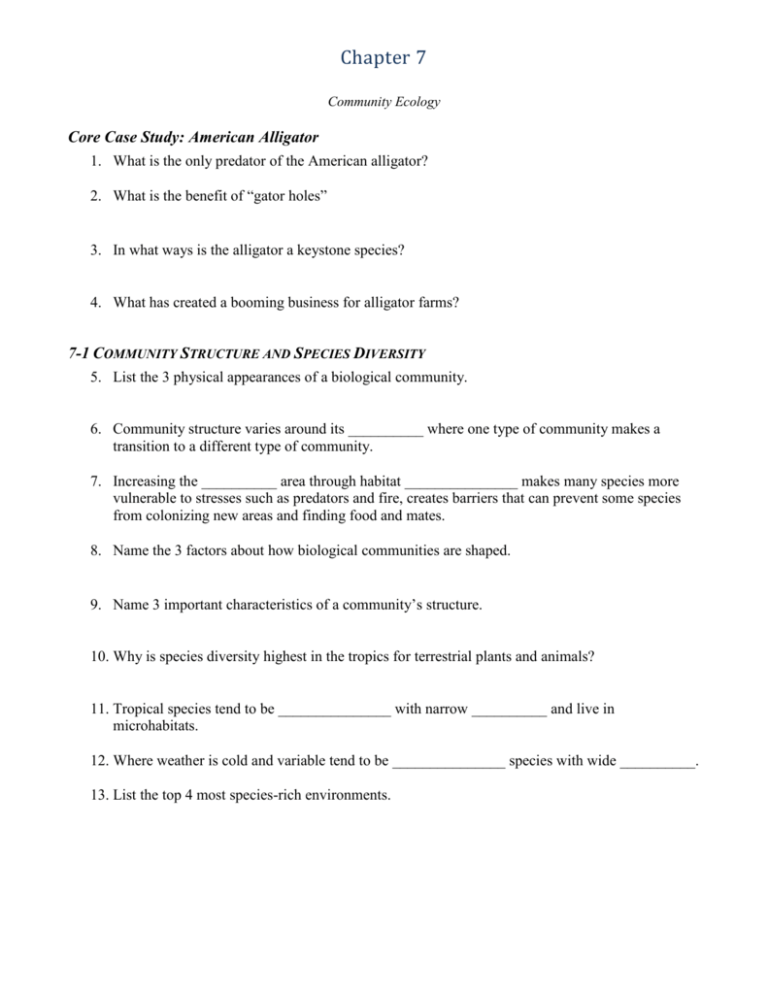
Chapter 7 Community Ecology Core Case Study: American Alligator 1. What is the only predator of the American alligator? 2. What is the benefit of “gator holes” 3. In what ways is the alligator a keystone species? 4. What has created a booming business for alligator farms? 7-1 COMMUNITY STRUCTURE AND SPECIES DIVERSITY 5. List the 3 physical appearances of a biological community. 6. Community structure varies around its __________ where one type of community makes a transition to a different type of community. 7. Increasing the __________ area through habitat _______________ makes many species more vulnerable to stresses such as predators and fire, creates barriers that can prevent some species from colonizing new areas and finding food and mates. 8. Name the 3 factors about how biological communities are shaped. 9. Name 3 important characteristics of a community’s structure. 10. Why is species diversity highest in the tropics for terrestrial plants and animals? 11. Tropical species tend to be _______________ with narrow __________ and live in microhabitats. 12. Where weather is cold and variable tend to be _______________ species with wide __________. 13. List the top 4 most species-rich environments. 7-2 TYPES OF SPECIES 14. What are the negative effects of a nonnative species? 15. Restate the theory of island biogeography. 16. Does island biogeography only apply to water islands? Explain. 17. What animals are excellent biological indicators? Why? 18. Why are amphibians susceptible to environment change? 19. List the 9 factors that affect frogs and other amphibians at various points in their life cycles. 20. What are the 3 reasons why amphibians are environmentally important? 21. Where is the keystone found in an architectural structure? 22. How is the dung beetle and Piaster orchaceus sea star classified as keystone species? 23. Why should we protect sharks? 24. What is the difference between a keystone species and a foundation species? 7-3 SPECIES INTERACTIONS: COMPETITION AND PREDATION 25. List the 5 basic types of interactions. 26. Give one example of resource partitioning. 27. How do predators ensure the “survival of the fittest”? 28. Name the 3 ways predators use to locate prey. 29. Name 4 ways predators use to capture prey. 30. Name 4 ways prey use to avoid predators. 31. What are E.O. Wilsons 2 rules of thumb for indicating if an animal species is dangerous? 32. What is an example of an animal colony that is cleaner than the skin of humans? 7-4 SPECIES INTERACTIONS: PARASITISM, MUTUALISM, AND COMMENSALISM 33. How do parasites promote biodiversity in a population? 34. List 4 examples of mutualistic relationships. 35. Is mutualism an example of cooperation between species? Explain. 7-5 ECOLOGICAL SUCCESSION: COMMUNITIES IN TRANSITION 36. Give an example of a pioneer species. 37. Describe the process of facilitation. 38. What is the first necessary step for primary succession? 39. Give an example of a midsuccessional species and a late successional species. 40. Is succession beneficial or harmful? Explain. 41. Restate the intermediate disturbance hypothesis. 42. Are late successional communities in a state of permanent equilibrium or in a state of continual disturbance? 7-6 ECOLOGICAL STABILITY AND SUSTAINABILITY 43. List the 3 aspects of stability or sustainability in living systems. 44. Do diverse communities tend to produce more biomass than simple communities? 45. Does species diversity in a community lead to greater stability or sustainability? 46. How much biodiversity is needed to help sustain various communities? 47. Evidence suggests that some communities have one of two properties, but not both. Name the 2 properties. 48. Are deserts fairly stable communities? CRITICAL THINKING 49. How would you experimentally determine whether an organism is a keystone species? 50. How would you experimentally determine whether two bird species feeding on the same plant are competing for the same resources or are engaged in resource partitioning? 51. Given limited financial resources, should we protect areas of higher biodiversity in the tropics over temperate and polar biomes. 52. Use the second law of thermodynamics to help explain why predators are generally less abundant than their prey. 53. Describe how natural selection can affect predator-prey relationships and how predator-prey relationships can affect natural selection. 54. How would you respond to the claim that we should not worry about our effects on natural systems because succession will heal the wounds of human activities and restore the balance of nature? 55. Give an example of each of the following interactions: a. Commensalistic interaction b. Mutualistic interaction c. Parasite-host relationship

